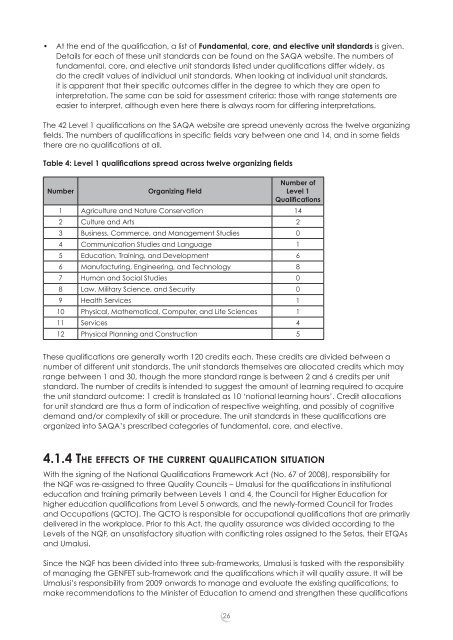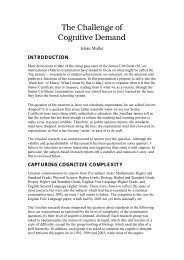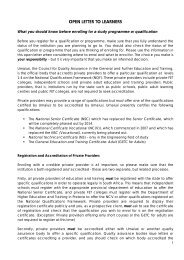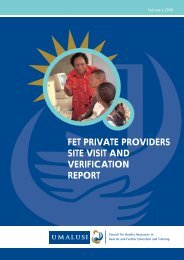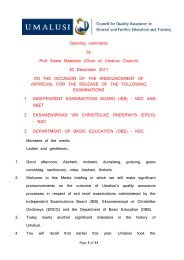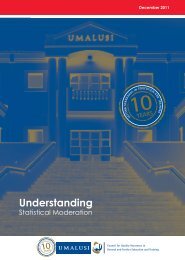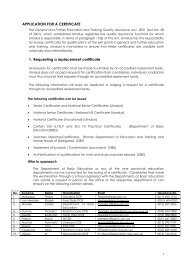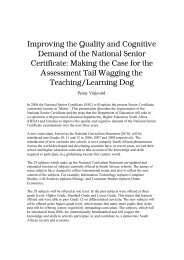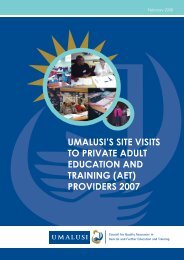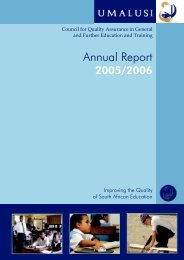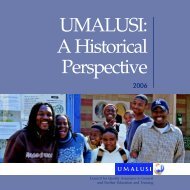Table 3: GETC: ABET Learning OutcomesGeneral Education and Training Certificate: Adult Basic Education and Training1. Use a range of communication, language, and learning strategies in a variety of contexts.2. Explain and use ma<strong>the</strong>matical strategies, techniques, and patterns to solve problems. OR3. Explain, select, and use numbers, data, and objects in everyday life situations.4. Investigate <strong>the</strong> process of making informed choices in order to develop and maintain a healthy lifestyleand positive relationships.The following set of generic Learning Outcomes apply to all <strong>the</strong> Additional Learning Areas associated with<strong>the</strong> Qualifi cation:1. Understand and use specifi c Learning Area knowledge2. Know and apply specifi c Learning Area skills3. Understand and analyze <strong>the</strong> values related to <strong>the</strong> Learning Area.The assessment criteria associated with <strong>the</strong> exit level outcomes are intended to provide <strong>the</strong>briefest description of <strong>the</strong> level at which <strong>the</strong> successful candidate is able consistently to achieve<strong>the</strong>se meta-outcomes.• General recommendations are made for Integrated Assessment. These suggestions are phrasedgenerically and <strong>the</strong>re is ample room for interpretation. The very vague and repetitive nature of<strong>the</strong> statements under this heading would suggest that <strong>the</strong> qualifi cation designers have made agesture in <strong>the</strong> direction of <strong>the</strong> SAQA requirements only.While reference to integrated assessment within <strong>the</strong> qualifi cation ensures that it is recognizedas a desired feature of <strong>the</strong> delivery, what integrated assessment means always requiresmuch more detailed unpacking, something which cannot be done within a qualifi cation, butwhich needs to be done in a curriculum. While <strong>the</strong> SAQA requirements focus on integratedassessment, a quality assurer such as <strong>Umalusi</strong> will have a lot more to say about assessmentgenerally, in terms of both external and internal assessment, and how it needs to be qualityassured.This information does not reside in <strong>the</strong> qualifi cation itself but within <strong>the</strong> qualityassurance framework which underlies <strong>the</strong> Council’s approach. Setas, too, will have had tounpack what <strong>the</strong>ir quality assurance requirements are for <strong>the</strong> integrated assessment of aqualifi cation. The model most frequently used by Setas is one of decentralized assessment usingassessors whose training for <strong>the</strong> work may have been completed in a course lasting no morethan a few days, and whose expertise in <strong>the</strong> subject fi eld may not be very different from thosebeing assessed.• Under International comparability, brief descriptions of comparable qualifi cations in o<strong>the</strong>r partsof <strong>the</strong> world are provided, where such exist. The attempts to ascertain comparability differ interms of <strong>the</strong> number of countries in which similar qualifi cations have been sought. Comparabilitydiffers in two dimensions: in terms of <strong>the</strong> specifi c countries that have similar qualifi cations, and<strong>the</strong> degree to which <strong>the</strong> qualifi cations are, in fact, comparable. The descriptions provided differin <strong>the</strong>ir degree of specifi city: some list <strong>the</strong> internationally comparable qualifi cations, while o<strong>the</strong>rsstate generally that <strong>the</strong>re are comparable qualifi cations.• Articulation options are given where horizontal links to related courses exist on <strong>the</strong> same level,or where vertical links to courses at higher levels exist. Articulation can be horizontal or vertical,or both. Articulation options do not, however, always exist. Descriptions also differ in <strong>the</strong>irdegree of specifi city: some give <strong>the</strong> particular qualifi cations for which <strong>the</strong> current qualifi cationis preparation; o<strong>the</strong>rs mention very generally that <strong>the</strong> current course provides mobility acrossvarious fi elds and levels.• Under Moderation options and Criteria for <strong>the</strong> registration of assessors, general rules forassessment and moderation are given. Assessors and Moderators need to be more highlyqualifi ed for some qualifi cations than for o<strong>the</strong>rs; <strong>the</strong>re are more assessment and moderationrules for some qualifi cations than o<strong>the</strong>rs.25
• At <strong>the</strong> end of <strong>the</strong> qualifi cation, a list of Fundamental, core, and elective unit standards is given.Details for each of <strong>the</strong>se unit standards can be found on <strong>the</strong> SAQA website. The numbers offundamental, core, and elective unit standards listed under qualifi cations differ widely, asdo <strong>the</strong> credit values of individual unit standards. When looking at individual unit standards,it is apparent that <strong>the</strong>ir specifi c outcomes differ in <strong>the</strong> degree to which <strong>the</strong>y are open tointerpretation. The same can be said for assessment criteria: those with range statements areeasier to interpret, although even here <strong>the</strong>re is always room for differing interpretations.The 42 Level 1 qualifi cations on <strong>the</strong> SAQA website are spread unevenly across <strong>the</strong> twelve organizingfi elds. The numbers of qualifi cations in specifi c fi elds vary between one and 14, and in some fi elds<strong>the</strong>re are no qualifi cations at all.Table 4: Level 1 qualifications spread across twelve organizing fieldsNumberOrganizing FieldNumber ofLevel 1Qualifications1 Agriculture and Nature Conservation 142 Culture and Arts 23 Business, Commerce, and Management Studies 04 Communication Studies and Language 15 Education, Training, and Development 66 Manufacturing, Engineering, and Technology 87 Human and Social Studies 08 Law, Military Science, and Security 09 Health Services 110 Physical, Ma<strong>the</strong>matical, Computer, and Life Sciences 111 Services 412 Physical Planning and Construction 5These qualifi cations are generally worth 120 credits each. These credits are divided between anumber of different unit standards. The unit standards <strong>the</strong>mselves are allocated credits which mayrange between 1 and 30, though <strong>the</strong> more standard range is between 2 and 6 credits per unitstandard. The number of credits is intended to suggest <strong>the</strong> amount of learning required to acquire<strong>the</strong> unit standard outcome: 1 credit is translated as 10 ‘notional learning hours’. Credit allocationsfor unit standard are thus a form of indication of respective weighting, and possibly of cognitivedemand and/or complexity of skill or procedure. The unit standards in <strong>the</strong>se qualifi cations areorganized into SAQA’s prescribed categories of fundamental, core, and elective.4.1.4 THE EFFECTS OF THE CURRENT QUALIFICATION SITUATIONWith <strong>the</strong> signing of <strong>the</strong> National Qualifi cations Framework Act (No. 67 of 2008), responsibility for<strong>the</strong> NQF was re-assigned to three Quality Councils – <strong>Umalusi</strong> for <strong>the</strong> qualifi cations in institutionaleducation and training primarily between Levels 1 and 4, <strong>the</strong> Council for Higher Education forhigher education qualifi cations from Level 5 onwards, and <strong>the</strong> newly-formed Council for Tradesand Occupations (QCTO). The QCTO is responsible for occupational qualifi cations that are primarilydelivered in <strong>the</strong> workplace. Prior to this Act, <strong>the</strong> quality assurance was divided according to <strong>the</strong>Levels of <strong>the</strong> NQF, an unsatisfactory situation with confl icting roles assigned to <strong>the</strong> Setas, <strong>the</strong>ir ETQAsand <strong>Umalusi</strong>.Since <strong>the</strong> NQF has been divided into three sub-frameworks, <strong>Umalusi</strong> is tasked with <strong>the</strong> responsibilityof managing <strong>the</strong> GENFET sub-framework and <strong>the</strong> qualifi cations which it will quality assure. It will be<strong>Umalusi</strong>’s responsibility from 2009 onwards to manage and evaluate <strong>the</strong> existing qualifi cations, tomake recommendations to <strong>the</strong> Minister of Education to amend and streng<strong>the</strong>n <strong>the</strong>se qualifi cations26


